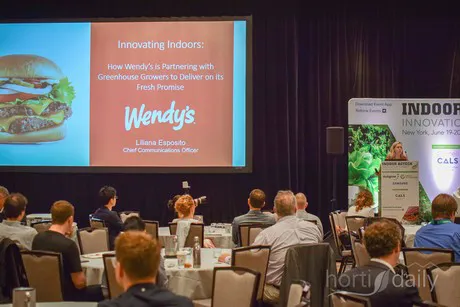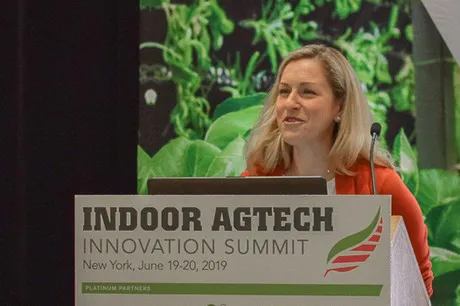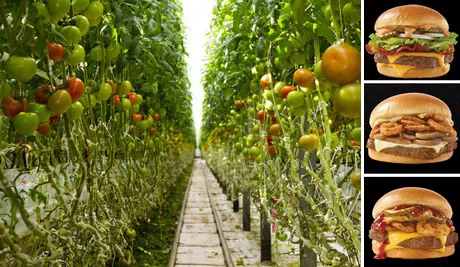It took a crisis and dissatisfaction with the tomatoes being served in their restaurants for burger chain Wendy’s to switch their tomato supply to indoor, hydroponic grown tomatoes. Nowadays a dozen greenhouse companies supply the 6,000 Wendy’s restaurants, and all burgers are made with greenhouse grown tomatoes. “Except for the Baconator since there are no tomatoes on that burger – although of course you can have it customized if you want to”, Liliana Esposito with Wendy’s explained at the Indoor AgTech.

Vine-ripened
Remember how last year Wendy's, the third-largest fast-food burger chain in the US, said it would only be sourcing vine-ripened greenhouse-grown tomatoes for use in its US and Canada locations? They’ve completed their mission. Now the company supplies their US and Canadian restaurants with indoor grown tomatoes only.
During the Indoor AgTech, Liliana Esposito, from Wendy’s, explained what motivated the company to do so, where they are now and what will be next. “Even though I’m impressed with the technology being used in the greenhouses, for us our shift to greenhouse tomatoes started with the quest for flavor and quality”, she said, before explaining how commodity tomatoes haven’t been able to impress her in terms of quality. “I personally love good tomatoes and will not buy a fast food tomato. However, when I ordered sandwiches at Wendy’s I would order them without a tomato since it didn’t taste good”, Liliana revealed. “Thanks to our work with greenhouse operators, this has significantly improved. That’s important to us: with the fast food chains of today we believe Americans deserve something better – a great hamburger made fresh, with fresh, North American beef. Vegetables are a key part of this great hamburger. That’s the basis of our company and by sticking to these quality measurements, we’ve grown to over 6,000 restaurants.”

Tomato shortage
Still, the shift to greenhouse grown tomatoes was initiated by a crisis. Back in 2010/2011, weather hit the industry hard and fast food restaurants had to deal with a tomato shortage as well. “Weather events made us run out of tomatoes. It was the case for the whole industry, as well as other crops. We started supplying tomatoes on request: only if you asked for them, they were put on your burger. With our operators willing to deliver the prefect hamburger, this for sure was a wake up call. From a supply perspective, we needed to do more to protect our customers.”
Anyhow - the crisis turned out to be a blessing as well. In their quest to find product wherever, Wendy’s started buying tomatoes from Mexico. “That was a pleasant surprise”, Liliana says. “Not in terms of price, since it was crisis in the industry, but the quality was better than we thought.” It made them curious to learn more about various ways of growing tomatoes and introduced them to hydroponic crops.
Securing supply chain
Following these discoveries and urged by the need to secure the supply chain, Wendy’s opted for an outdoor grown, vine-ripened product. During the same time more producers went into greenhouse production and the initial shadehouses grew to be more sophisticated growing instalments. Following the launch of a specialty salad, including fresh sliced cucumbers and red bell peppers, the team again was impressed by the quality of the greenhouse operators.
All together it resulted in a chain confident of their choice to secure their tomato supply from greenhouse growers only. The announcement was made to get in contact with additional suppliers. “We seriously evaluated two dozen facilities. A greenhouse doesn’t necessarily mean quality”, Liliana says. “Some companies didn’t live up to our standards. Ultimately half of them made their way into our supply chain, and not all of them made it on their first try.”

Sustainable benefits
“Now we also see other sustainable benefits. The reduced use of water and land for example, and the reduced exposure to pests and environmental challenges”, Liliana gives as an example. Then there’s the positive response from consumers, especially on the reduced use of chemical crop protection and the safe indoor working conditions – but all of these come second to the initial urge to start the shift because of supply assurance and flavor and quality improvements.
So what’s next? Indoor grown bell peppers (even though they’re not bought by Wendy’s at the moment), spring berries, lettuce or onions? “We’re looking at all of it. We don’t feel our tomato journey is complete and believe we can unlock more in terms of flavor for example. We’re confident that we’re getting there, with our suppliers and through the value chain”, Liliana says. Then there’s lettuce. “Nearly all of our sandwiches have lettuce on them – except the Baconater – and there’s many promises in the area. It will involve further collaboration, upgrading of the quality and avoiding waste where we can. Whatever comes next, it will be fresh.”
